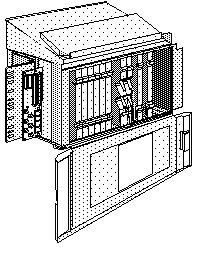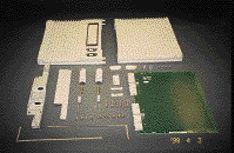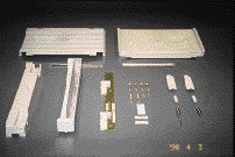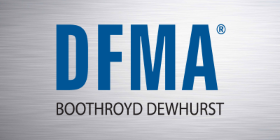The Signal for Success
Nortel engineers dramatically lower product costs using DFX principles and design for manufacture and assembly (DFMA), a design analysis tool developed by Boothroyd Dewhurst, Inc.
Recently, Nortel product engineers in Electronic Systems Packaging utilized Boothroyd-Dewhurst DFMA to redesign two products in the company’s broadband portfolio, the S/DMS TransportNode OC-3 Express and the S/DMS TransportNode OC-192 ("OC" is "optical carrier"). The function of the TransportNode family of products is to carry voice, video and data transmissions along an interconnected synchronous optical network (SONET). Established as a U.S. standard for fiber-optic transport of communications traffic, the SONET backbone supports speeds from just over 50 megabits per second to almost 10 gigabits per second.
Given the varied requirements its customers have for the volume of transmissions that must be carried, Nortel designs an array of transport products with different characteristics. The systems-packaging engineers have the task of devising housings for the electronic circuitry inside the TransportNode products. The OC-3 Express and the OC-192 stand at either end of Nortel’s TransportNode product line. The redesign projects presented unique challenges to the packaging engineers as they embarked upon DFMA.
Beat the competitor’s price
A compact unit contained in a single armload-sized shelf, the TransportNode OC-3 Express shelf carries 2,016 calls per optical fiber at a speed of 155.52 megabits per second. It provides a low-cost way of extending SONET capabilities to small and medium applications, such as an office park, a school setting up for distance learning, or a neighborhood organization of telecommuters. The modular OC-3 Express, the "one-shelf solution" to transport-system needs, is essentially a six-sided sheet-metal box containing telecommunication components. It measures 14.75 in. across by 11 in. deep by 14 in. high, including a removable air deflector and fiber storage tray. The original shelf had a front cover, back cover, and welded shell for the sides, top, and bottom and cost $276 each to make (U.S. dollar amounts).
The original OC-3 Express was a successful design, but it did not reach the market soon enough. It offered more features and flexibility than the competitor’s version and promised broader marker penetration, but the competitor soon lowered the price on its more mature product. In response, Nortel’s product designers began to look for ways to reduce costs to match the competitor’s tactic.
"We had a couple of different ideas to get at," explains Dean Flockton, mechanical systems design engineer. "We wanted to make cost reductions, and we wanted to make the unit more environmentally friendly." For the latter requirement, a major goal was to eliminate 8 feet of beryllium-copper gasket and to find an alternative to the zinc chromate plating used to control corrosion of the sheet metal. Flockton also had to discover a way to double the fiber-carrying capacity of the unit.
The engineering team targeted the shelf mechanics, the box itself, for cost reduction. Following Boothroyd-Dewhurst DFMA principles, the project team disassembled the original OC-3 Express shelf and analyzed the function of each part. Flockton quickly realized that the front cover of the shelf was a strong focus for redesign. A DFA analysis of the original design showed that the hinged aluminum front cover of the box alone consisted of 53 parts and cost $78 to make. A majority of the parts were fasteners. As the analysis process continued, with feedback solicited from vendors and customers, a redesign strategy evolved: tool the front cover in plastic and replace fasteners with snaps where possible. The redesigned cover consisted of only 17 parts and took only 95 seconds to assemble, versus 378 seconds for the original cover. The total parts cost for the new cover was $26, a savings of $52 per unit.
Flockton offers a memorable example of DFMA yielding productive collaboration with suppliers. In a visit to the sheet-metal vendor, the Nortel team discovered that a stainless-steel gasket used in the front cover was being cut with a laser at a cost of $20. Because the gasket was only 0.005" thick, the group decided to use a steel-rule die operation instead, which lowered the cost of the gasket to $5.
Redesign efforts for the remainder of the shelf resulted in similar savings. After learning from customers that access through the rear of the unit was not needed, Flockton incorporated the separate back cover into the welded shell, which eliminated $32 of beryllium-copper gasketing no longer necessary for electromagnetic interference shielding. He redesigned the welded shell itself into C-shaped main and subshelves that nest for easier assembly. The subshelf, which integrates the electronic components, now slides into the main shelf, and the sides of the box weld on at slotted mounting tabs. Much of Flockton’s redesign was aimed at reducing assembly complexity. He explains, "I changed the way the welded box went together so it required less spinning around to assemble. It used to have welds on four sides, but now there are welds only on two. The front cover is also now all one-axis assembly."
In all, DFMA-guided redesign of the OC-3 Express shelf mechanics resulted in a total cost of $136, a considerable reduction as compared to the original cost of $276. The expected savings to Nortel in assembly and manufacturing costs are estimated at $700,800 annually.
Reduce the cost of a standard assembly
The TransportNode OC-192 is a seven-foot, closet-sized cabinet of equipment that provides the most sophisticated bandwidth management available in the communications industry today. The OC-192 carries 129,024 calls on each optical fiber at a speed of 9.95 gigabits per second. With wave division multiplexing, which expands the number of light wavelengths that a single fiber can carry, the OC-192 can transport over 250,000 calls per fiber at speeds up to 160 gigabits per second. Forming part of the worldwide telecommunications backbone, the device is used to interconnect supercomputers in business and education and to consolidate and direct huge volumes of transmissions.
Unlike the OC-3 Express, the OC-192 emerged before competitors’ versions and is still capturing a large portion of market share. It is the world’s highest-capacity transport system and sets the standard in the telecommunications industry for next-generation fiber transport platforms. In 1997 the TransportNode OC-192 won an award from the International Engineering Consortium for innovation, uniqueness, market impact, customer benefit and value to society.
The TransportNode OC-192 consists of several shelves of components that provide device control, manage the fiber optics, and contain fans
For cooling the unit. Installed on the transport shelf, the heart of the system, are a variety of circuit packs, which are modules that function as transmitters, receivers, regenerators or switches. Each transport shelf has enough space for ten circuit packs, which fit, like books into a bookshelf, into vertical slots about 2 in. wide, 12 in. tall, and 10 in. deep. Depending on the customer’s requirements, fewer than ten active circuit packs may be installed. Filler packs are inserted into the vertical slots unoccupied by active circuit packs.
A filler pack is more than just a dummy circuit pack with a nice face. It contains a printed circuit board that plugs into the backplane of the unit, signaling to the operating system that a pack is in place and blocking electromagnetic interference that would otherwise radiate out the opening. It also works in concert with the active packs to manage the flow of air that cools the entire system. Initially, filler packs were constructed using parts and castings from active packs. As sales of the OC-192 grew, however, a large number of filler packs were being shipped out. Because filler packs are provided at no extra charge to the customer, the design team identified an opportunity to reduce the total cost of the OC-192 by reducing the cost of the filler packs.
Using the Boothroyd-Dewhurst DFMA method, the design team was able to reduce the cost of a filler pack from $410 to $65 (U.S. dollar amounts). The total number of parts was reduced from 59 to 32, and the time to assemble each filler pack was cut by two-thirds, from 15 minutes to 5 minutes. The entire redesign process, from defining the functional requirements to producing the part was only 10 months. The annual expected cost savings to Nortel was estimated to be $3.45 million.
This disassembled original filler pack for the TransportNode OC-192 cost $410 to make and took 15 minutes to assemble.
The redesigned filler pack cost $65 to make, took five minutes to assemble, and used about half the parts of the original unit.







